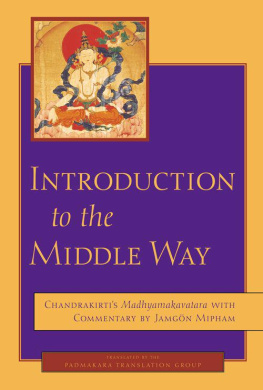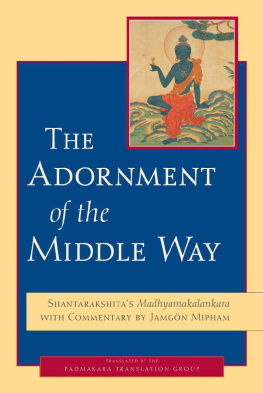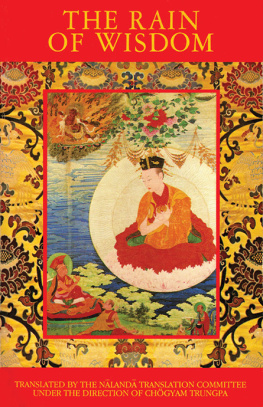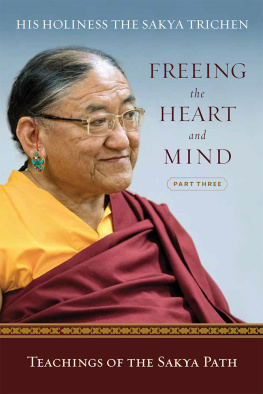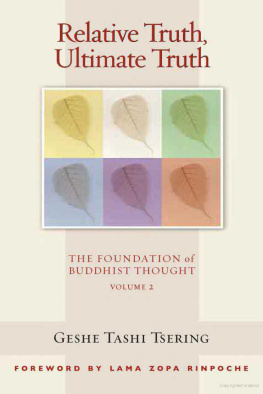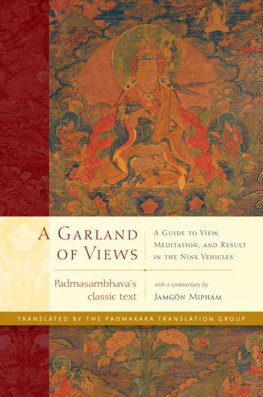I am delighted with this translation of Mipham Rinpoches Sword of Wisdom. Personally, this text has helped me so much in understanding the system of basic logic and reasoning that elucidates the profound meaning of the two truths. It is a true gem for beginners and learned alike. Time and time again, it can serve as an invaluable resource to refine and deepen ones knowledge of all schools of the Buddhadharma.
Dzigar Kongtrul Rinpoche
____________________
Miphams Sword of Wisdom explores the Nyingma-lineage understanding of valid cognition in Vajrayana Buddhism. This translation, a clear and concise primer on higher realization through valid cognition in Buddhist philosophy, presents these ideas in English for the very first time and includes the sutra presentation of the two truths and the tantra teachings of the two truths as the purity and equality of all phenomena.
When youve finished Miphams Sword of Wisdom, youll have
rich insights into Nyingma teachings on valid cognition,
a profound new understanding of the two truths and their inseparability,
a solid foundation in valid cognition through direct perception and reasoning according to the traditional Indian treatises of Dharmakirti and Dignaga,
and much more.
More praise for
Miphams Sword of Wisdom
The great scholar and advanced spiritual master Jamgon Miphams Sword of Wisdom is a classic work that explicates valid cognition. I am happy to see it now available in English with commentary and scholarly appendices that will be very helpful for serious students in understanding this profound and important text.
HIS HOLINESS THE SAKYA TRICHEN
I am very pleased that this seminal text by the first Mipham has been translated and made available in English. This book presents direct perception and reasoning as the most valid way to know reality, starting with the truth of cause and effect and extending to the realization of nondual wisdom.
SAKYONG MIPHAM RINPOCH
Miphams Sword of Wisdom is the essence of the Dharma itself! Khenchen Palden Sherab was a true lineage holder and scholar, a compassionate and humble man whose work can be trusted to be in perfect accord with the teachings of all the lineage masters, so we can rely on his teachings with absolute confidence. This text contains the power, blessing, and kindness of the incomparable Mipham Rinpoch, so it is like the very soul and heart of Manjur himself! It is my heartfelt prayer that everyone read this text and take these teachings purely and honestly into their hearts.
VEN. GYATRUL RINPOCH
Although we think we have understood emptiness as the ultimate teaching of the sutras and tantras, we havent really delved into the depths of its meaning and still continue to see things with ordinary perception and are unable to rest freely in the ultimate true nature. Mipham provides the tools for us to actualize the supreme timeless awareness and become naturally liberated and boundlessly compassionate, which is the final result of our practice.
HIS HOLINESS SHENPEN DAWA NORBU RINPOCH
I have found it to be extremely well written and with great blessings. I am reminded constantly of Khenchen Rinpochs teachings and his kindness, and I found boundless joy in this sublime work.
KHENPO TSEWANG GYATSO
Translators Introduction

ON THE CONTENTS OF THIS BOOK
This book contains the root text of 104 verses by Jamgn Mipham Rinpoch titled The Sword of Wisdom That Ascertains Reality, followed by a commentary by Khenchen Palden Sherab Rinpoch titled The Radiant Light of the Sun and Moon. Also included in this volume is Miphams autocommentary on The Sword of Wisdom. These annotations to the verses make Miphams intended meaning clear and form the basis for Khenchen Paldens commentary.
Perhaps the greatest value of this very rich, classical text is in being a clear and concise primer on Buddhist philosophy and valid cognition. Its core subject matter is the Buddhist view of the two truths the relative truth of conventional appearances and the absolute truth of emptiness and buddha nature and how the two truths are inseparable. The main questions this text poses are: How can we actually know the two truths? And how can we be certain that our knowledge is accurate? Miphams answer is that to know the two truths we need prama or valid cognition, as demonstrated through reasoning, and to gain certainty we need the four reliances. This is summed up in verse 92:
The supreme, stainless cause
is the possession of the four reliances,
which come from contemplating how the Dharma of the two truths
is established by the four types of reasoning.
This book excels in giving an easily understandable overview of valid cognition. What is valid cognition? It is accurate knowing, which we experience through direct perception and correct inference. Valid cognition is a topic of Buddhism rarely taught to Westerners, as it can seem either too simplistic or too complex, and it requires sustained study to get a good foundation in it. This text provides that foundation by explaining direct perception and inference according to the traditional Indian treatises of Dharmakrti and Dignga, and then by laying out the four reasonings: the efficacy of causes, the dependency of effects, the relative and ultimate natures of things, and the construction of valid proofs.
Along with valid cognition, the commentary discusses several of the topics traditionally studied in the shedras, the monastic colleges of Tibetan Buddhism. For instance, there are topics from Abhidharma such as the six causes, five effects, and four conditions, a discussion of general and specific phenomena, and the ten fields of knowledge. The section on prama, or valid cognition, includes material used for formal debate, such as various types of correct and false reasons, and these are illustrated with sample syllogisms. The section on direct perception includes a discussion of yogic direct perception and self-aware direct perception, so it also touches on meditation. As well, there is some discussion of the schools of Madhyamaka philosophy when Khenchen Palden points out the distinctions between Prsagika Madhyamaka and Svtantrika Madhyamaka in their approach to the absolute truth.
This root text and commentary exemplify the view of the Nyingma lineage of Tibetan Buddhism as set forth by Jamgn Mipham. It is one of the first books in English to present the Nyingma lineage understanding of valid cognition and its usage in Buddhist philosophy in general and in the Vajrayna teachings in particular. The Vajrayna section of the book follows the Guhyagarbha Tantra in discussing the two truths from the perspective of purity and equality: the relative truth is the purity of all phenomena and the absolute truth is the equality of all phenomena. Echoing the Guhyagarbha, Jamgn Mipham and Khenchen Palden introduce the Vajrayna reasoning of the four realizations, the six parameters and four styles of interpretation, the Buddhas eight intentions, and the primacy of self-knowing awareness. Miphams text makes it clear that higher realization depends on valid cognition, so we need to know what valid cognition consists of, how to train in it, and how to apply it in practice. As he says in the section on fruition, these methods are undoubtedly a genuine path because they result in genuine realization.
It might be useful to add that Khenchen Paldens commentary is written in the classical Tibetan scholarly style. Each section begins with a root verse, commentary that usually includes every word of the root verse, and then scriptural citations to support the statements made in the root verse. From one point of view this style of adding quotation after quotation can seem redundant, but from another point of view this is a chance to read in English portions of the greatest Indian philosophical works by Ngrjuna, Candrakrti, Candragomin, Dharmakrti, Dignga, and others. There are also quotations from the early Buddhist masters of Tibet, such as King Trisong Detsen, Kawa Paltsek, and Chokro Lui Gyaltsen. Most of us will never read their books on valid cognition, particularly since so few have been translated into Western languages. By including numerous quotations, we come to know what some of the most famous Buddhist masters said on the topics in this text.



